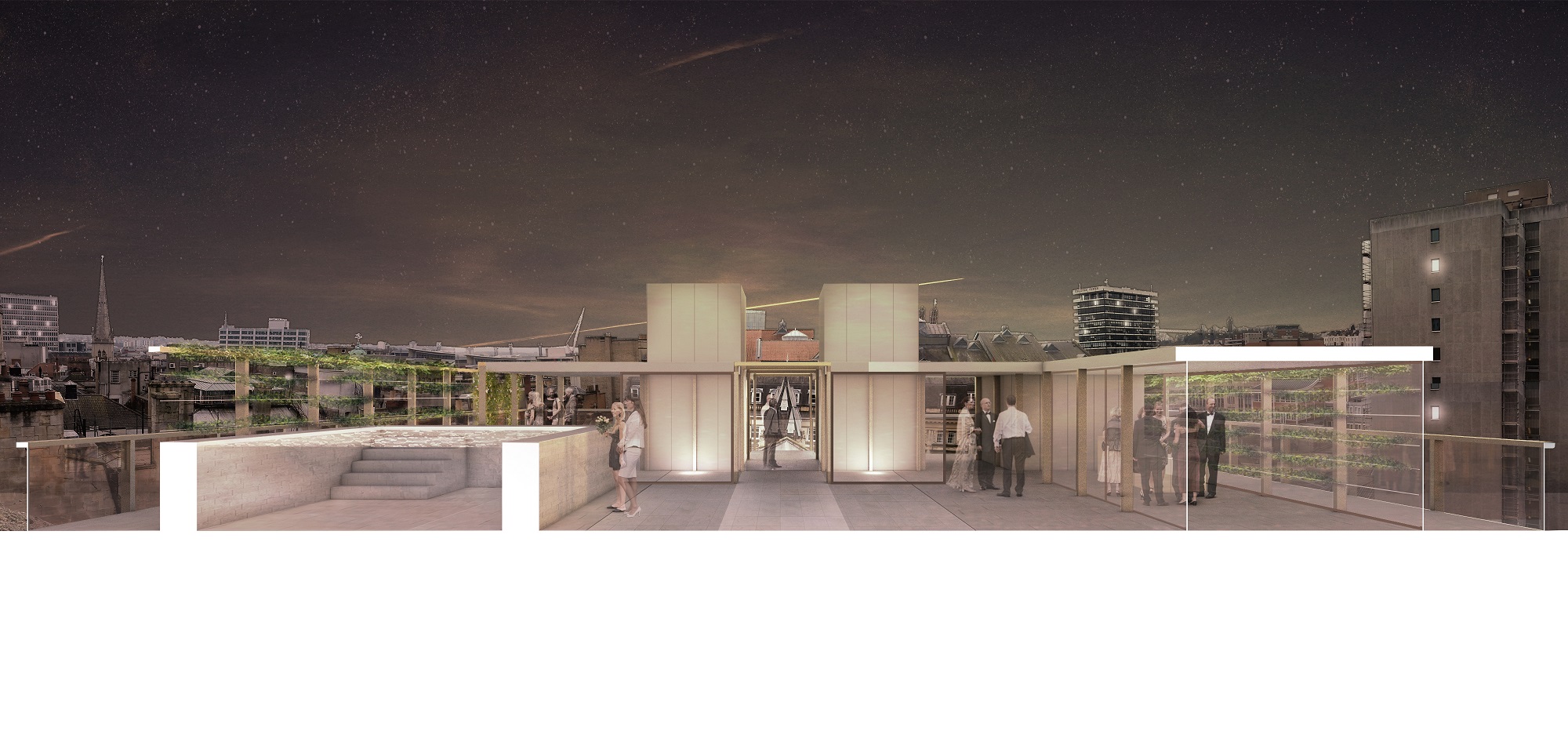Bristol city centre is to get its first 5-star hotel following planning approval for the transformation of the historic Guildhall and Assizes Courts into a 91-bedroom spa hotel with rooftop swimming pool.
The 62,000 sq ft Grade II* listed building, which has impressive facades on Corn Street and Broad Street in the heart of the Old City, was bought two years ago by The Trevor Osborne Property Group – a Bath-based specialist in converting historic properties into exclusive hotels.
It has since worked with award-winning Bath architects Feilden Clegg Bradley Studios to draw up innovative plans to restore historic parts of the rambling building while transforming its more modern aspects.
Planning permission and listed building consent was received this week from Bristol City Council. Preliminary work will start in January with the opening scheduled in December 2017.
The Guildhall’s 91 luxury en suite bedrooms will be built around its existing towers, pitched roofs, dormer windows and even statues of famous judges, with each room having its own unique style and layout.
The cobbled Jail Van Yard, which connects Small Street to Broad Street and where judges and the accused would arrive for court hearings, will be opened up to the public to provide access to the hotel’s bar and restaurant and feature atmospheric lighting and an outdoor cafe seating area.
The Crown Prosecution Service’s grim prison cells in the basement will be converted into unique changing rooms for the hotel’s luxury gym and spa.
Osborne Property Group chairman Trevor Osborne said: “We are very excited to be bringing new life to these historic and important Bristol buildings. This will be a high-quality hotel under high-quality management, representing a step change in the fortunes of Broad Street.”
Feilden Clegg Bradley Studios architect for the Guildhall Hotel refurbishment, Charles Wellingham, added: “Our proposals will open up this important building in Bristol’s history, allowing it to be appreciated by residents and visitors whilst also contributing to the vital renewal of this part of the city.”
The plans have been welcomed by Destination Bristol, the organisation promoting the city the business visitors and tourists,
Chief executive John Hirst said: “Surprisingly, Bristol does not have a true 5-star hotel so the luxury 5-star Guildhall Hotel will be an exciting additional string to our bow and a great boost for Bristol at a very key time for the tourism industry.
“I’m also very much looking forward to sampling the rooftop pool!”
The Guildhall and Assizes Courts were built in two stages – 1843 and 1886 – by architect Richard Shackleton Pope in the Tudor Collegiate style.
Built on the foundations of the earlier medieval Guildhall, the site has been a place of law since records began. The Guildhall is marked on the earliest map of the area dated 1673 and was referred to in written records dating back to 1328.
Due to extensive bombing in 1940, which destroyed most of the Guildhall behind its neo-Gothic facade and led to its development in the 1960’s as the main courts for Bristol, not all of the Guildhall’s original interiors remain, however, those that do are being incorporated into the new hotel.
The impressive oak-panelled Nisi Prius courtroom, which features high-level leaded windows, magnificent 10m-high beamed ceiling, and even the judge’s ceremonial dias is being restored and will offer a unique new venue for Bristol conferences and events.
Recent excavations uncovered parts of a merchant townhouse, which is believed to date back to the 12th century. A large, ornate 16th-century limestone fireplace, which until recently dominated one of the Guildhall’s law court rooms, is being carefully dismantled and restored and will become a dramatic focal point for the bar area of the hotel.
Two storeys of flooring will be removed to open up the Guildhall’s original 1843 tower entrance on Broad Street and create an impressive, triple-height reception area.
The tower’s stained-glass windows and original statues will be restored, which include famous figures such as Queen Victoria; Edward III, who granted Bristol its county charter in 1373; the 17th century Bristol MP and Red Maids’ school founder John Whitson, and Bristol merchant, MP and philanthropist Edward Colston.
It is thought that Colston’s house on Small Street was incorporated into the fabric of the Guildhall building in 1868.
The initial stripping out and excavation work will begin in January 2016, with the main building contract starting in May. The work is estimated to take approximately 18 months and the proposed opening date for the new Guildhall Hotel is December 2017.
The Osborne Group, whose projects include the award-winning Oxford Castle and the conversion of the Grade I listed Buxton Crescent into a luxury thermal spa hotel, also bought the adjoining Grade I listed former Bank of England building, which will be incorporated into the scheme.
Built in 1847 by leading British architect Charles Robert Cockerell, who also designed the Ashmolean Museum in Oxford, the handsome Broad Street building was one of the first Bank of England branches outside Threadneedle Street in London.
Pictured: An artist’s impression of the Guildhall Hotel’s roof terrace






























